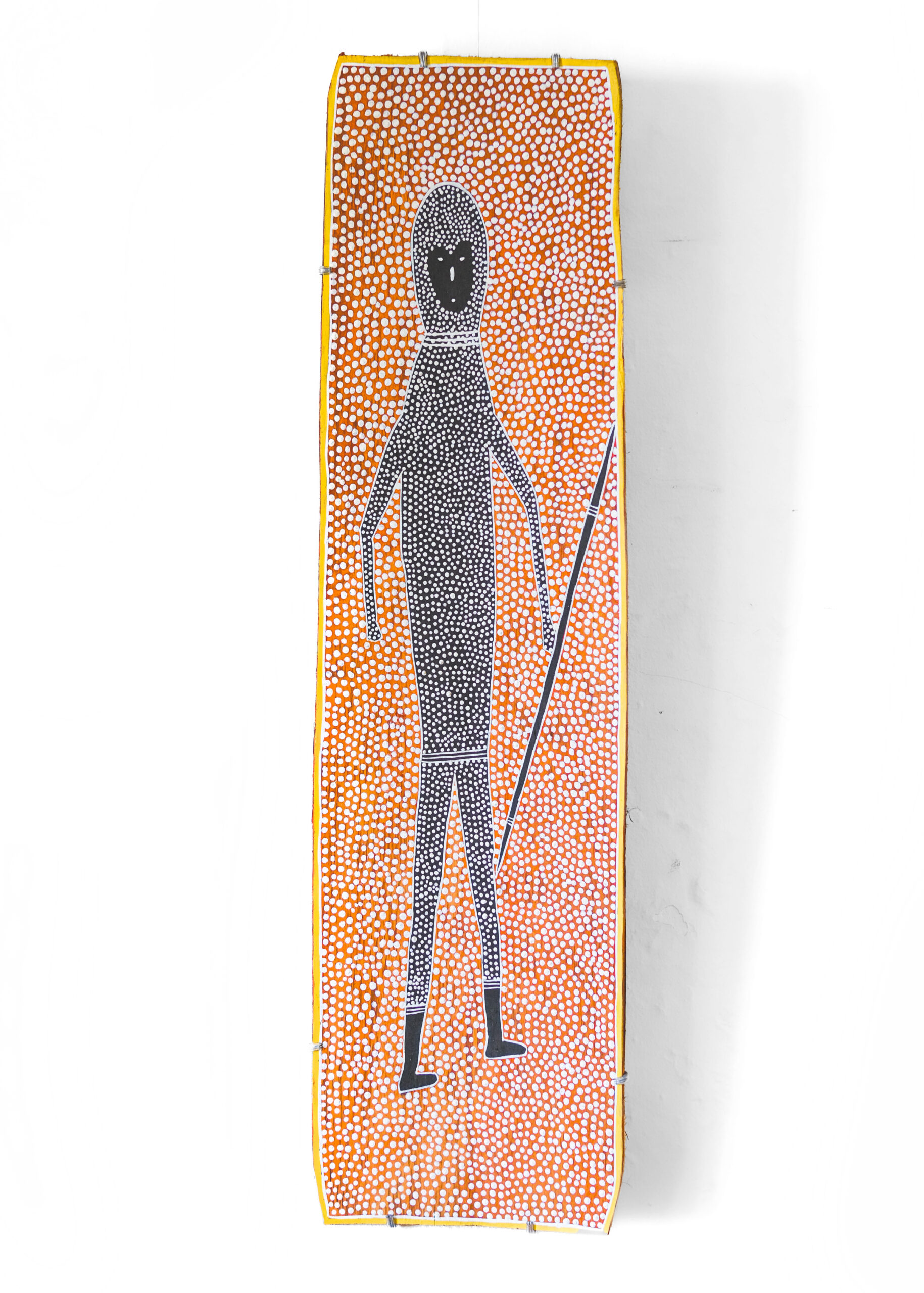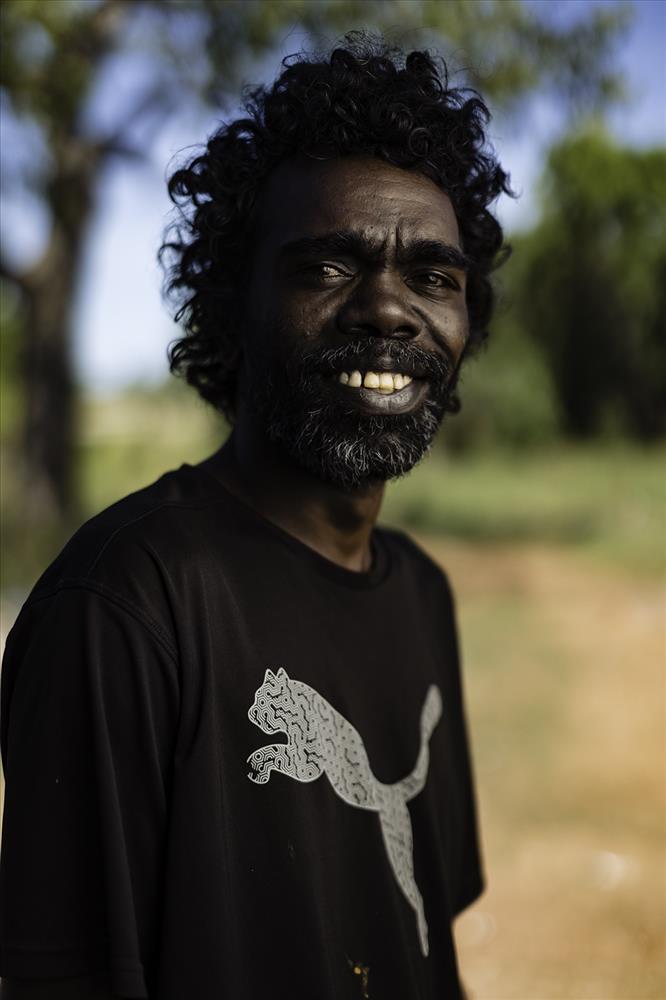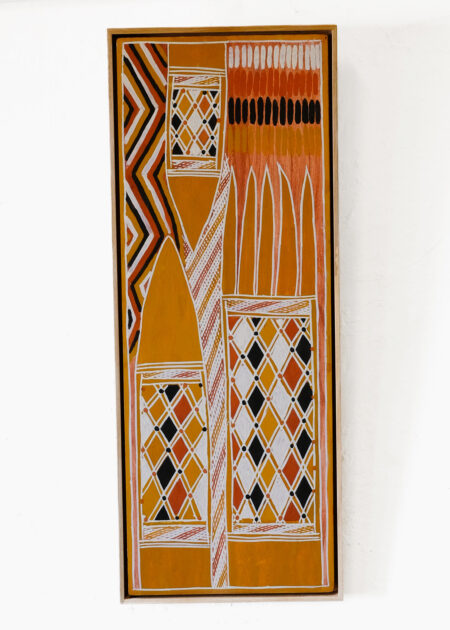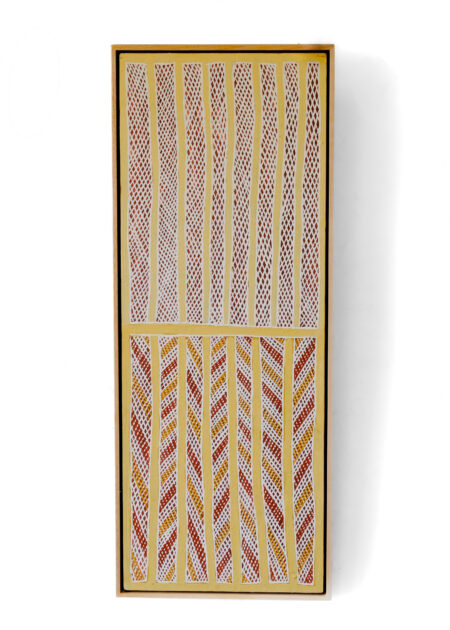Description
This work depicts Warrabunbun, the powerful forest spirit belonging to the artist’s märi (mother’s mother) Warrawarra clan. Sometimes also called Wuypa, the spirit inhabits land between Garmu and Gamurra Gu-yurra just south of Milingimbi on the mainland and is said to be over 10 feet tall.
Warrabunbun is not the spirit of a person, but a maḻagatj, a supernatural being that looks after Warrawarra country and kin. While considered a protective and benevolent spirit that watches over you, it is acknowledged that Warrabunbun can be märr maḏakaḏitj – a bit dangerous or aggressive – if startled or offended. He carries with him a spear and spear-thrower for defence, and is sometimes depicted with a broken leg from when he was once caught in a skirmish defending his land from invaders. Warrabunbun is also said to be djambatji, a prodigious hunter, that can easily spear emu, wallaby and goanna.
The artist Matthew Djipurrtjun explains,
Yow, dhuwal Warrabunbun mokuy. Manymak, yurr ŋayi dhuwal nhawi, marrŋgitj ŋayi, balanya. Marrŋgitj — birrimbirr balanya. Ga wäŋaŋurnydja ŋayi dhuwal nhanŋu ŋunha Garmuŋur. Ŋunhi nhanŋu wäŋa, Garmu — Murlmurlma ŋunha.
Yes, this is Warrabunbun spirit. He is like a medicine-man or sorcerer – a spirit-man – something like that. His home is over at Garmu (on the mainland near Milingimbi), at a place called Murlmurlma.
Ga dhawaṯthun ŋayi dhuwal, breakfast, munhakumirr. Marrtjin maṉḏa — ŋayi ga ŋerrk — gapuw dhiṯthunaraw. Ga manymak, ga beŋuryi maṉḏa roŋiyiny ga balanya-bili wäŋalil, ŋunhi wanhaŋur ŋayi dhawaṯthun wäŋaŋur. Ga dhärri ŋayi baladhi.
He comes out at breakfast, early in the morning just before the sun comes up. Warrabunbun and Ŋyerrk the white cockatoo, they leave to collect water. Yes, and then they return to the same place, the place from where he came out. And there he stands.
Ga beŋuryidhiny, dhuḏi-milmitjpan — munhay’nha waluy — ga dhawaṯthuna bili ŋayi, ga gapuw dhiṯthunaraw — ŋayiny maṉḏa Mun-ngokngoknha, ŋurukidhi gapuw, wäŋaŋur Murlmurlma, yäkuŋur ŋunhi maŋutji.
And from there, in the evening, when night falls, he leaves again and goes to get water — he and Mun-ngokngok, the owl spirit, at Murlmurlma, the name for that waterhole.
Djipurrtjun goes on to explain that Ŋyerrk the white cockatoo and Mun-ngokngok the night owl are his companions that alert him to danger or the presence of newcomers, and if you hear their cry you know that Warrabunbun is nearby. He usually hides in the shade in the thick parts of monsoon vine forest that grow around the waterhole at Murlmurlma, and sometimes can be heard crying or whistling out himself – at nighttime sometimes you hear him: “Gooooo Yuuuuuu”. He makes a torch out of stringybark by tying it up and setting it alight. When he wants water, he scoops it up with raŋan (paperbark). When he sees the native yam jamandarr, he cooks it and eats it, along with dhaŋgi (billygoat plum) and warraga (cycad nuts). To make fire he rubs two sticks together. In Burarra we say of these sticks, an-ngurtga awu barra, meaning literally, “it will give fire”.
The stories and songs of Warrabunbun are rich source of strength for Warrawarra clan and their kin. The various episodes, themes and connections present in the larger story of Warrabunbun means these artworks often depict him in different contexts and may focus on particular elements. Some of these include various foods or objects, often described as his ‘tools’, including the aforementioned spear and spear-thrower, a digging stick to harvest the jamandarr yams and a special Warrawarra dillybag called burlupurr that he uses to carry his catch or harvest. Warrabunbun is also associated with larger Yirritja moiety song cycles that connect him with ratjuk (barramundi), ginyginy (catfish), gurtha (fire) and bäru (crocodile). The waters of Murlmurlma are represented by the white rärrk cross-hatching enclosed in a circle.
Warrabunbun is also said to ‘come alive’ during ceremony, especially during Dhapi’ (intiation) and Bäpurru (Funeral) cermonies. The late Thomas Dhaburrul, who was senior gutharra custodian of the Warrawarra clan, explains,
“When Warrawarra people have a Dhapi’, all the dancers and song leaders have a catfish design painted on their chest (just like Warrabunbun). They decide with the boy what design he will have – his own clan design, his ŋathi (mother’s father) design, or his märi (mother’s mother) design. When a boy has his Dhapi, it is his future. It is a time for passing on the knowledge to the new generation. If a family member passes away, I sing the Warrabunbun song and the Warrabunbun spirits come up from the jungle area and they dance, and we dance as well. Sometimes I hear their voices. If you get lost, they can take you back to your house.”
Senior Warrawarra leader and master weaver Susan Balbuŋa, who is responsible for weaving the Warrawarra burlupurr dillybag, explains,
Ŋunhi napurr dhu ŋayatham mokuy, dead body, Yirritja yolŋu, napurr dhu giritjirr ga bathi gurrkam. Ŋunhi napurr dhu dhawaṯmaram mokuy, beŋurdhi, napurr dhu ḏäḏa – bukuḻup – ga napurr dhu ŋal’maram dharpalil.
When we hold a mokuy, a dead body, (a funeral), [for a] Yirritja person, we dance and wear this bag. When we finish the funeral, after that we have a cleansing ceremony – and we hang [the bag] up on a pole. Then we are free.




